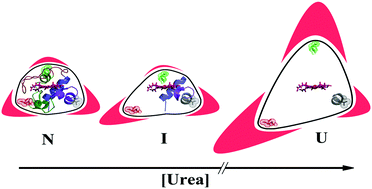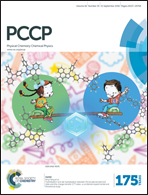Studies of cytochrome c-551 unfolding using fluorescence correlation spectroscopy and other biophysical techniques†
Abstract
In this paper, we have studied the equilibrium unfolding transitions of cytochrome c from Pseudomonas aeruginosa (cytc551), a small bacterial protein. Similar to eukaryotic cytochrome c, cytc551 folds sequentially, although significant differences exist in the order of folding units (foldons). There are two regions of cytc551 (N-terminal helix with residue number 3 to 10 and the loop 2 region containing residues 34 to 45), in which no foldon unit could be assigned. In addition, the helix containing the Cys-X-X-Cys-His motif, adjacent to the N-terminal helix (residue number 3 to 10), shows unexplained ultra-fast collapse. To obtain further insights, we have studied cytc551 site-directed mutants using fluorescence correlation spectroscopy (FCS) and molecular dynamics simulation. We have found out that cytc551 unfolds through the formation of a fluorescently dark intermediate state and the amplitude of the dark component depends on the position of labeling. We have utilized this position dependence to propose a shape change model during the unfolding of cytc551. The present results show that the N-terminal helix remains in a collapsed position even in the completely unfolded state and this helix may act as a rigid support to guide the folding of its adjacent helix. This rigid support may be responsible for the ultra-fast collapse of the adjacent helix region, which occurs during the initial events of folding. The present results also show that the C-terminal end of loop 2 traverses a large distance during unfolding compared to the N-terminal end, which justifies the observed flexibility of the loop 2 region.


 Please wait while we load your content...
Please wait while we load your content...